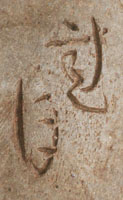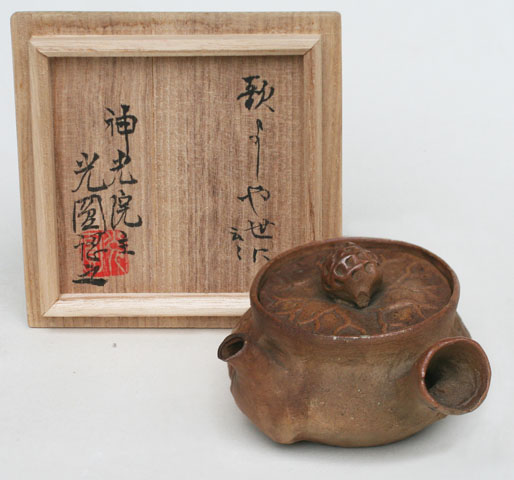waka
Kyûsu, side handled teapotSigned: Rengetsu
Seals:
Technique: Tambayaki, pottery from Tamba with a lotus shaped lid with pine cone and with a bronze like skin. Rengetsu incised her poem while the clay was still wet. Ø 8,3 x (11,5) x 5,6
Box: authorized by Hôin Tokuda Kôen (1935-2011)
Condition: used, fine
The waka reads:
よしや世を/ながれわたりの/みづからも/濁(にご)らぬかたに/すまんとぞ思(おも)ふ。(5-7-5-7-8 (!)
Yoshiyase wo/nagarete watari no / mizukara mo/ nigora nukata ni / sumantozo omofu.
Even for one,
who was washed down
through the so-called worldly life
I think about settling down
in calm waters. (transl. Sayumi Takahashi, Black robe, white mist p. 35 # 41)
or:
Yoshi ya yo wo / nagare watari no / mizukara mo / nigora nu kata ni / suma n to zo omou.
So, like water
flowing through
this world... I too
in an unmuddied place
wish to live pure. (The Rengetsu Foundation Project)
Rengetsu was born in Kyoto. Within a few days after her birth the Õtagaki family adopted her. In 1798 she moved to Kameoka castle to serve the Matsudaira family. Here she studied the woman’s pursuits such as poetry and calligraphy, but she received training in martial arts as well. In 1807 she returned to her family in Kyoto where she married her adopted brother, a young samurai called Mochihisa. In the eight years of her marriage she gave birth to three children, who all died shortly after their birth. In 1815 she divorced her husband, who was to die shortly after. She remarried but already in 1823 her second husband died. She cut her hair and became a nun and took the name Rengetsu, Lotus moon.
With her daughter from her second marriage and her stepfather she moved into a small building on the grounds of the Chion-in. Two years later her daughter died. Without means of support she moved to Okazaki in the Kyoto area together with many artists, where she produced pottery and studied Shijô painting with Matsumura Keibun (1779-1843). She fell in love with Keibun and they lived together. She intensively studied waka. In spite of being a nun, men made advances to her, but not being interested, she pulled out her teeth to look less attractive and to strengthen her inner self. Her pottery became such a big success that she escaped her customers many times and moved more than thirty times, even thirteen times in one year.
She became close friends with Tomioka Tessai (1836-1924) and even tried to adopt him as a son. For the last 25 years of her life he helped and accompanied her. On the invitation of the Abbot Wada Gozan (Gesshin) (1800-1870) she spent her last years in a tea hut on the grounds of the Jinko-in temple where she deeply immersed herself in the study of Buddhism but she also continued her artistic occupations.
Reference:
Kyoto 2014
Canberra 2007
Roberts p. 129
Fister '88 pp. 144-159 (# 69-76)
Price: SOLD

